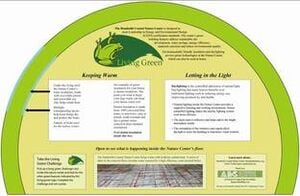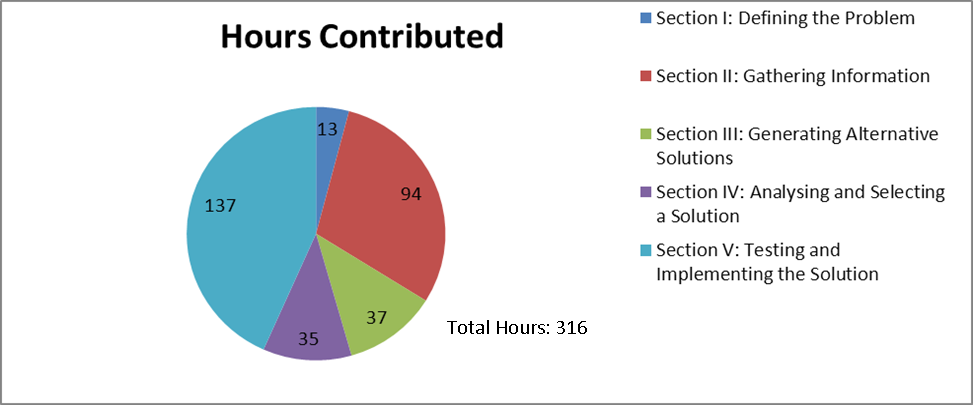FOTD living green, warm and bright display

The Living Green Warm & Bright Display[edit | edit source]
Abstract[edit | edit source]
Background[edit | edit source]
Friends of the Dunes [1] in Manila recently finished major renovations to the former Stamp's house, transforming the building into a Green Building Council. Many visitors are unaware of the green technologies used in HCNC. The executive director of Friends of the Dunes, client Carol Vander Meer[2] wanted a display for visitors to learn about the green technologies used at HCNC and to encourage them to develop a green lifestyle.
Specifications[edit | edit source]
The specifications are the requirements from the client criteria and must be implemented throughout the designing of the project. The following specifications will be adhered to during the design process:
- Location: Humboldt Coastal Nature Center, Manila, California, United States of America
- The exhibit is interactive.
- The exhibit is adaptable for future changes.
- The exhibit is low maintenance.
Considerations[edit | edit source]
Considerations while building the exhibit are:
- People of all ages will be using the display.
- People will be using the display upon arrival or departure.
- The location will be visited by mainly English and Spanish speakers.
- The display will be outside for three months during the summer.
Client Criteria[edit | edit source]
The criteria are a list of standards in which the final project will be judged upon. The list was formulated by the group and the client and is defined by it constraints which are the measurable properties of the criteria.
| Criteria Weights | ||
|---|---|---|
| Criteria | Average Weight | Description |
| Adaptability | 4 | The ability of the exhibit to change over time, whether it be physically moved or altered within the project. |
| Site Appropriateness | 7 | The aesthetics and information given harmonizes with the local environment /Stamp House. |
| Ease of Use | 7 | The simplicity of the interactive components of the exhibit for general public use. |
| Appropriate Materials Used | 6 | The ability of the project to be made with "green" materials, including materials that are re-purposed, from local sources, or certified for environmental sustainability by a professional independent organization. |
| Educational Value | 10 | The use of multiple learning channels so the exhibit effectively conveys the material. |
| Cost | 3 | The costs of building materials and tools will be within the $400 budget. |
| Attractiveness | 8 | The ability of the project to attract visitors to the exhibit while maintaining the neutral local aesthetics. |
| Durability | 5 | The structural longevity of the exhibit and all of its components. The exhibit needs to be able to withstand weather conditions and children for at least 3 months. |
| User Safety | 4 | The level of precaution needed so that visitors will not get hurt when interacting with the exhibit. |
| Duration of Interest | 6 | The length of time visitors are intrigued when interacting with the display. |
Design[edit | edit source]

The exhibit is built almost exclusively using environmentally conscious materials. The four distinguishable parts of the exhibit are the base, interactive elements, and the display. The base is constructed of driftwood which was collected near Friends of the Dunes. The driftwood is heat treated, sanded and stained. The bottom of the base is cemented to a 5 gallon BPA free bucket and buried 2 feet deep in the ground. The top of the drift wood that connects to the display is cut to a 30 degree angle so the display has a lower profile.
The display which contains the informational content is the shape of a half circle, imitating the shape of the Humboldt Coastal Nature Center. The outer edge green to represent the green roof of the HCNC and the inside of the display is an aesthetically pleasing sandy yellow color. Written in the display is a brief overview about the new friends of the dunes building as well as the LEED certification standard for green buildings. The display teaches visitors about two main components of the green technologies used to gain LEED certification.
The sign has three main areas of focus insulation, Daylighting, and radiant floor heating. Two types of environmentally friendly insulation are described and presented on the display for visitors to interact with. The soy based foam insulation, used in the HCNC, as well as the denim insulation are able to be touched by visitors. The next area, Daylighting, is another interactive element that connects to Daylighting application at the HCNC. Mock windows are located near the center of the display. The windows have shutters with hinges, and underneath is information about Daylighting advantages and Daylighting at the HCNC. The last area, radiant floor heating, has a a wooden flap that can be opened up. Under the flap is information about radiant floor heating at HCNC along with a picture of the system. On top of these three areas there is a game called the "Green Living Challenge" located at the bottom of the sign, which challenges visitors to find all the Living Green logos around the HCNC in order to win a prize. The display has a section dedicated to recommending sources to learn more about the Friends of the Dunes, green technologies and environmentally friendly building supplies.
Costs[edit | edit source]
The Cost of the Exhibit is separated into three sections: The cost in hours it takes to build, the cost in dollars for materials, and the cost to maintain the exhibit.
Material Cost[edit | edit source]
These are the costs of materials used in the construction of Green Living Warm and Bright interactive exhibit. The total amount spent to construct the project was $248.73. Because the wood from the project was acquired for below market value. The total projected costs for Looney Dunes is $283.73.
| Material | Quantity | Our Cost ($) | Retail Cost ($) |
|---|---|---|---|
| Wood | 1 | 45.00 | 60.00 |
| Screws | 25 | 0.30 | 0.30 |
| Sand Paper | 6 | 5.94 | 5.94 |
| Zero VOC Stain | 1 | 27.03 | 27.03 |
| Plexiglass (12",24") | 1 | 26.91 | 26.91 |
| Bucket | 1 | 7.99 | 8.15 |
| Bag of Concrete | 1 | 6.99 | 7.42 |
| Epoxy Adhesive | 1 | 5.39 | 5.39 |
| Hinge | 3 | 16.17 | 16.17 |
| Paint Brush | 1 | 4.49 | 4.49 |
| Alupanel Printing | 1 | 117.50 | 117.50 |
| Total Cost | $248.73 | $263.73 | |
Design Cost[edit | edit source]
The design costs indicate the amount of hours that Looney Dunes put into this design project. A total of 316 hours were spent on this design project. The majority of the design hours were spent in phase 5. The figure below represents the amount of time in required for each phase of the design process from the initial definition of the problem to the finished solution.

Maintenance[edit | edit source]
The Exhibit requires minimal maintenance. Once every week the display of the exhibit should be wiped down with a damp cloth. Every two months hinges need to be cleaned and the denim insulation needs to be replaced by new denim insulation. A year's worth of denim insulation pieces are supplied for replacements. After a year, insulation will need to be obtained from The Alternative Building Center[3] in Humboldt California. The foam insulation will need to be replaced every three months or when needed. A year's worth of replacement foam pieces is supplied. After a year, foam insulation will need to be obtained from the original source.
How to Re-Create[edit | edit source]
-
Step 1: Develop an appropriate sign layout
-
Step 2: Gather the needed materials to construct the exhibit
-
Step 3: Find a driftwood base and cut top a desired angle
-
Step 4: Stain all wood for water resistance.
-
Step 5: Construct plexiglass box and flaps.
-
Step 6: Attach box and flaps to sign.
-
Step 7: Secure the half circle wood to driftwood base
-
Step 8: Last, attach the display to the half circle wood.
Video[edit | edit source]
Here is a video of the sign in use at the Humboldt Coastal Nature Center
Discussion[edit | edit source]
The resulting Living Green Warm and Bright exhibit is an effective way to educate visitors about the HCNC, Green Technologies, and Living Green. The interpretive sign is easy to read and attracts people with its unique look. Younger Kids enjoy playing with the mock windows and touching the insulation. People can read about the Humboldt Coastal Nature center as well as living green. The display is very sturdy because the buried cement bucket makes a solid base. All stationary pieces on the display are tightly bonded to the display. The hinges are oriented so that they cannot be over extended and break. The exhibit fits each the criteria exceptionally. The natural stain colors of the base as well as the sandy color of the display make the exhibit visually tasteful. The display is simple and educates visitors about Humboldt Coastal Nature Center and living green via interaction and information. The interpretive sign's height is adjustable, and its low profile allows for it to be interacted with from a wheel chair. From the driftwood base to the information in the display, the Green Living Warm and Bright interactive exhibit represents the Humboldt Coastal Nature center and provides a brief overview about living green for visitors.
Next Steps[edit | edit source]
The two areas of improvement for the exhibit is to increase durability of the sign and interactivity within the sign. The sign is built to last for one summer outside, so improvements can be made to make this sign more permanent. The other area of improvement for this display is interactivity. Adding different methods of interactions can increase the level of engagement in the sign.
Contact details[edit | edit source]
Team Looney Dunes









